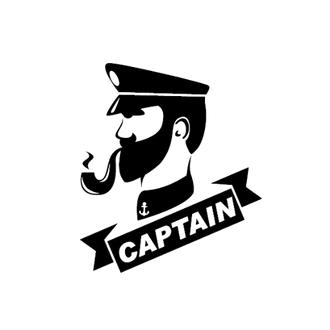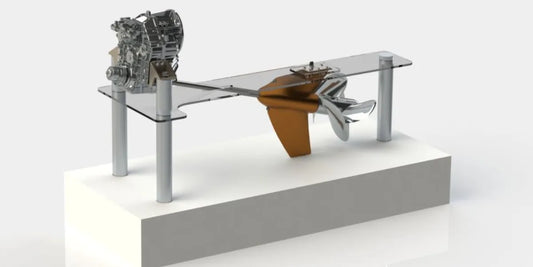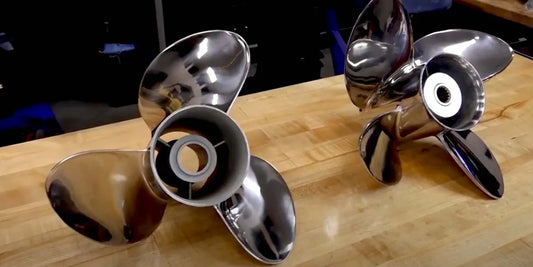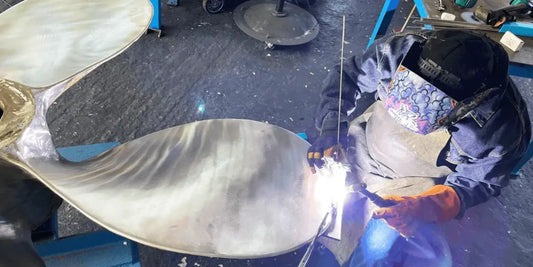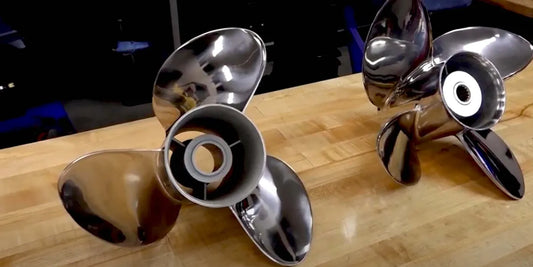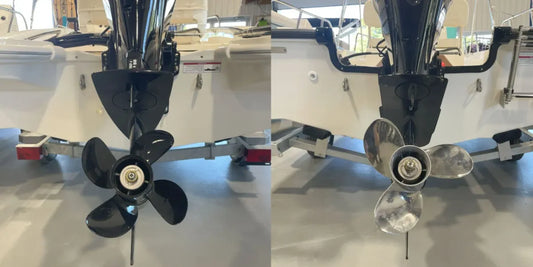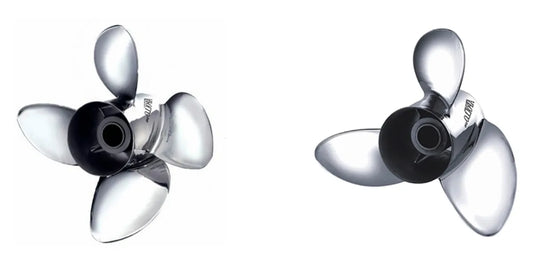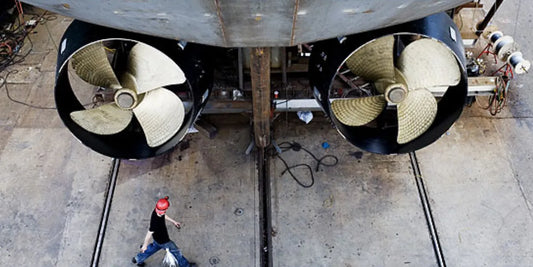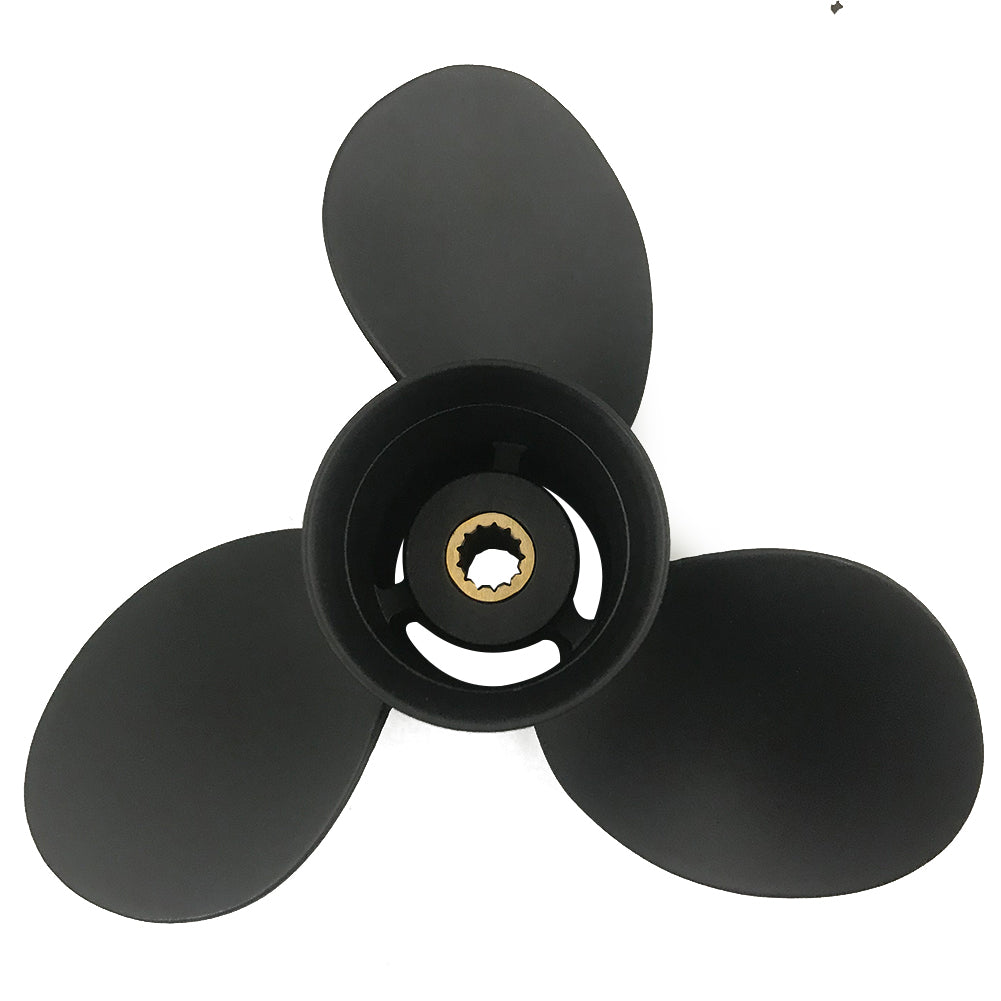For avid boaters and water enthusiasts, ensuring their vessels perform at the highest level is of utmost priority, especially while at sea. The propeller hub is one such component that impacts a boat's efficiency, speed, and handling. However, most novice and experienced boaters must contend with spun prop hubs, often leading to unsatisfactory or dire performance during use. This article will elaborate on the mechanics of a spun prop hub, explain how to look for symptoms of this problem, and cover reasonable measures that can be taken to boost, restore, or even enhance your vessel's performance. Taking proactive measures to understand and tackle these matters will enable you to know how to make your boating experience trouble-free and smooth.
What causes a spun prop hub on a boat?

Common reasons for a propeller hub to spin
The spun prop hub is a problem that usually occurs due to deterioration or failure of the internal rubber bushing of the propeller hub. The troublesome bushing gradually deforms bespoke, losing the capability to connect the propeller and drive shaft. Below are the most reasonable factors:
Excessive Torque or Force: Any propeller may be subjected to forceful torque, especially when encountering a submerged object, which is likely to cause the rubber bushing to dislocate. Newer model hubs have a built-in buffer that reduces the strain on the drive trains; however, consistent impact places undue stress on the bushing.
Heat and Friction: Operating at high RPM for a prolonged period generates more heat, which causes permanent softer and less aggressive bushing material. This behavior is rampant in vessels set to full throttle for long durations.
Aging and Material Degradation: Rubber parts, especially in older prop hubs, tend to lose their mechanical strength and stiffness over time due to greater exposure to water, changes in temperature, and ultraviolet light. This leads to lower resistance to spinning.
Improper Installation or Maintenance: A poorly installed propeller can create unbalanced force due to misalignment, leading to quicker deterioration of the hub. Also, failure to perform routine checks can cover up some forms of relatively severe damage.
Boaters can recognize the factors likely to affect propeller hub maintenance and provide decisions that could help reduce the chances of failure.
How does impact with underwater objects affect the prop hub
Striking underwater obstacles can result in serious breakages to the prop hub, such as misalignment, cracking, or complete detachment. An impact on the propeller can create an excessive force surpassing the hub's design features and capacity. Such an impact can cause the rubber insert to shear or the inner splines to become deformed while striking an object.
The primary aspects of consideration are:
Impact Force: The impact force which is measured in Newtons, relies heavily on the rate of speed of the vessel as well as its weight. Impacting forces significantly increase the likelihood of damage.
Material Strength: The tensile strength that must be comprehended to know how resistant to damage is called ZMPa. This strength has eminent factors such as stress and strain, which define boundaries of the common bad or rubber material.
RPM (Revolutions Per Minute): When the RPM is too high at the time of the impact, the transmitted impacts through the propeller systems become greater.
In the case of suspected impacts, consistent inspections are crucial in determining the concealed effects of the damage to the hub and its scope in the long run.
The role of excessive engine RPM in spinning a prop hub
Eliminating even one hub’s material will increase Engine RPM during the stress phase due to accurate choke positioning on takeoff. Indeed, excessive engine RPM increases the forces on the propeller system, leading to a greater possibility of sabotaging the spinning of a prop hub. In turn, when the engine RPM surpasses the set limits, the overload on the hub's base becomes extraordinarily high, translating to the heightened chances of inflicting fatigue or falling apart. About the abrasion noted above, here are the other critical technical notes that ought to be referred:
Twelve years after my submission, Peak design stress tolerance: The propeller hub material must contain sufficient electric tensile strength measured in MPa minimum. The widespread stress surpasses the significant risk of progressive impairment or total failure.
The electorate's Primary Vibration Frequency is measured at 50 degrees Celsius. The vibration of the engine and propeller is higher at higher RPM, resulting in unhindered vibration frequencies, which leads to an imbalance in the hub, which is prone to more effortless wearing and decreased durability.
The nominated Baseline For Nominal Uninterrupted Achievable Horsepower for more the power achievable limit per shaft 22 of each ENG 1000 propeller driven at a higher RP, further commanding integration of extensions. Spending more time with such ETS invariably damages the hub as the Structural integrity gets overwhelmed.
The braking Torque nominal hub enables a single statistical force reserve available at high engine rpm to bypass the propulsion system's energy virtually. RPM and Kinetic energy are the only existing sources. With lowered shock, the utmost proportion of force is triggered during sudden shocks or bumps. Such movements expand the kinetic amount that the hub receives.
Frequent evaluation of the provided parameters and recommended RPM ceiling makes certain chances of shaft spinning and all related damages are minimal.
How can I check if my boat's propeller hub is spun?

Visual signs of a spun propeller hub
A hub with a spun propeller will exhibit certain critical problematic features and signs. Listed below are both visual and performance-based markers you should observe:
Irregularly High Engine RPM With No Speed Increase: An unusually high engine rev with no speed increase could indicate a hub issue. The proposed explanation for this is that the hub in question is more or less slipping, meaning it is failing to transfer enough power to the propeller.
Loss of Acceleration or Decreased Thrust: A marked decrease in thrust or an inability to get the boat up to speed might indicate another key problem. If the propeller cannot grip water as firmly as it should due to a hub problem, it could suggest a hub problem.
Frictional Burn Marks With Scorched Rubber: While trying to dismount the propeller, you may notice the hub rubber bushing bearing scorch marks or overheating clues. The rationalization here is that the friction that arises as a result of the slip accounts for this.
Visual Offset Between Prop Bialde and Plastic Hub: The propeller's housing may internally offset the hub, so its relative position should be checked.
You can identify a spun propeller hub by looking at the above signs and data. Following this will allow you to resolve the issue as soon as possible.
Performance indicators of a spun prop
When a diagnosis is made on a spun propeller hub, watching a set of performance and technical parameters is critical to ensure the problem exists. Some of them are:
Lower Speed at High RPMs: If the engine's RPMs increase but the boat's speed does not increase, some slippage is probable. It is important to check the current speed and RPMs against your boat's standard performance data.
Loss of Acceleration: When the spun hub is present, acceleration suffers, and the boat cannot plan or is significantly delayed in its response. Looking at the change in acceleration performance compared to normal operating conditions will reveal the answer.
Erratic Movement of the Propeller: Look at the propeller shaft while the engine is running or being turned manually. The hub can spin but, in so doing, can develop substantial misalignment, and because of that, rotation is governed such that the blades are out of phase with the hub.
Burn stains and excessive heating: Look for evidence of burns or overheating in the hub's rubber bushing. This results from too much slippage friction and may confirm that friction damage has occurred to the hub.
Reduced Efficiency: General inefficiency in the boat's behavior, such as increased fuel burn and reduced top speed, may indicate an issue with the hub performance. It is advisable to perform the measurements over long periods to see changes.
This study demonstrates that by carefully examining the performance indicators alongside the technical parameters, one can ascertain whether a spun propeller hub is the cause of the issue and adjust accordingly.
Using specialized tools to diagnose a spun hub
Diagnosing a spun propeller hub is an exercise in precision, and it often requires using purpose-built devices. The following tools and tips may help you address your concerns:
Torque Wrench: Use a torque wrench to check the propeller nut's tightness and confirm that it balances the manufacturer's set values. Attention to detail is essential here, as being too tight or using Slack might result in slippage.
Propeller Hub Inspection Jig: A jig can hold the propeller while you conduct a forces test to determine if slippage occurs. This allows you to determine whether the hub is slipping under load without entirely removing the propeller.
Marking Test: Mark the hub and propeller using chalk or any available marker to ensure a line crosses them. Subsequently, run the engine under a light load for a short duration and check the marks after a short duration. Marks that do not line up correctly indicate hub slippage.
Load and RPM Measurements: Use step testing devices with a tachometer to switch on the load and mark the RPM for each step selected. An indication of possible hub failure is increased RPM but with the boat performing poorly. Pay attention to the values outside the RPM range that are standard as stipulated by the propeller manufacturer.
Visual Inspection with a Puller Tool: Inspection marking by the visual method is possible using a propeller puller where the hub is removed and examined for telltale signs of deterioration, such as cracks or visible deformities.
When diagnosing a spun hub, these tools and measurements, with the torque values, RPM smoothness, and other configuration attributes, enable you to precisely determine the issue and implement corrective measures.
What are the advantages of a spun prop hub system?

Protection for the lower unit and propeller shaft
The spun prop hub system is essential in protecting the lower unit and propeller shaft by dampening the effect of sudden torque changes. The spun hub relieves the torque transmitted to the propeller shaft whenever the propeller hits an impediment. This injury mitigation minimizes the risk of severe consequences such as bent shafts or broken gears.
Torque Limitation: The spun hub slips at a torque limit, sacrificing mechanical effectiveness and alleviating damageable forces.
RPM Consistency: If the hub exhibits unusual wear, assessing RPM fluctuations under load would reveal irregularities.
Material Integrity: Ensure the hub components, especially the rubber or polymer materials, do not lose their structural integrity, which is required to safeguard against shock and protect the interconnected systems.
Shearing Threshold: The hub's material must possess a calibrated shearing threshold that guarantees failure without unwanted damage to other parts.
By concentrating on the above parameters, the spun prop hub system has, to an extent, functioned as a safeguard for marine propulsion systems regarding their durability and longevity.
Improved safety features of spun hub propellers
Spun hub propellers have several enhanced operational safety features to minimize damage to the propulsion system or the vessel. The added safety features include:
Absorption of Shock: Spun hub propellers are designed with flexible shock-absorbing members, such as rubber or polymer, to protect the internal components of the gear system from sudden impacts.
Control of Collapse: The specific strength required to shear the completed hub is designed at the level where system destruction will NOT occur. It permits the hub to Yield safely while excellent torque, strong enough to destroy the joint, is applied to it. This helps prevent the destruction of the propeller shaft and propulsion engine.
Prevention of Radial Alignment Deviation: Spun hubs allow robust controlling of alignment caused by minor material loss or impact, maintaining the requisite power for propulsion.
These features enhance operational safety while incurring expensive repairs to marine propulsion systems is minimized.
Cost-effectiveness of replaceable hub systems
Systems Incorporating Replaceable Hubs (SRH) are economical because they eliminate the need for complete propeller replacement after damage or progressive wear. Only the hub can be replaced, eliminating assembly time and material costs. This method drastically minimizes downtime and, as a result, maintains operational availability.
Torque Capacity
Replaceable hubs are assumed to be capable of withstanding the defined torque limits. This ensures that there is no overloading and the hub fails in a controlled manner before critical damage occurs to other vital parts.
Justification: The operational limit is, within this context, usually set about engine parameters and working conditions to find the most suitable overall strength and safety solution.
Compatibility
Replaceable hubs can simultaneously match various propeller designs and engine types without any further modification.
Justification: Universal designs facilitate manufacturing, enhancing simplicity and ensuring ready interchangeability.
Material Durability
Composite or high-grade metal alloys are placed under regular wear expectations without operational failure and, therefore, are selected with high performance in mind.
Justification: Material selection improves effectiveness while maintaining economic efficiency in restoration.
Ease of Maintenance
Replaceable hubs are intended to be removed and installed with ease, which reduces time and, therefore, labor costs.
Justification: Rapid repair increases the economic responsiveness resulting from mechanical failings while sustaining low operating costs.
By applying these technical parameters, cost-effective and functional replaceable hub systems mitigate long-term maintenance costs while enhancing the efficiency of marine propulsion systems.
How do I fix a spun prop on my boat?

DIY methods for repairing a spun propeller hub
As I was trying to fix a spun propeller bug, the first thing that came to mind was evaluating assessment damage. In cases where the propeller hub is considerably used up or completely broken, I like to swap it out. Below are some of the methods I use during the repair process:
Removing the propeller To avoid damaging the propeller shaft and having direct access to the hub region that needs evaluation and fixing, the initial step I need to take is to remove the propeller.
Inspection of Propeller Hub: After taking it out, I always examine the propeller hub alongside the rubber insert. If the rubber insert looks cracked, torn, or deteriorated, I know I must replace the hub, as trying to reuse such damaged components would jeopardize efficiency.
Rehub the Hub: If necessary, I replace the old hub with a new one using the appropriate tool set or a hub press. This latest addition restores the propeller's structural integrity.
Replace the Propeller: After replacing the hub, I reattach the propeller, ensuring that every part is secure and properly aligned for optimal performance.
By performing all these steps, I can maintain the shafts' flanges while complying with the technical parameters that seek maximum efficiency, durability, and ease of maintenance.
When to seek professional help at a prop shop
Obtaining assistance from a prop shop is paramount when the repair techniques at my disposal are too basic, and damage needs more specialized tools or expertise. For example, suppose there appear to be deep bends, cracks, or warping beyond basic repair techniques. In that case, the damage must be inspected and repaired by a professional so as not to compromise safety and performance. Moreover, if, after my adjustments, the propeller experiences chronic vibration or even imbalance, that could imply a need for expert equipment and precise calibration.
The corresponding technical parameters affected include the following:
Propeller Balance - If the imbalance remains uncorrected, severe vibrations could damage the engine and degrade performance levels while increasing the overall wear and tear of the drive system.
Structural Integrity—Substantial neglect of deformities and cracks could cause the propeller to malfunction or even fail during critical operational processes.
Efficiency and Performance - Blades that are not adequately repaired or even aligned result in lower thrust and energy consumption, which raises the question of effectiveness.
Durability - Unprofessional repair changes lead to accelerated material fatigue over time and loss of structural integrity.
By employing professionals when it is strictly necessary, I am afforded the comfort of knowing the propeller is safe for utilization while ensuring durability on its performance standards.
Replacing vs. repairing a spun prop hub
When determining whether to replace or repair a spun prop hub, I consider the damage’s scope and its effect on performance. When the hub is moderately worn and can be repaired, it may sometimes be cost-effective. However, if the damage is extensive and/or repairs would make the propeller unreliable, it must be replaced for safety and functionality.
If these matters are left unchecked, they could affect the following broken parameters:
Technical Issues - A given hub that has been improperly repaired can cause and disrupt the balance, leading to vibrations that can damage and harm the engine plus the drive system.
Balanced Forces—After some time, a repaired hub that is not fully functional will ultimately fail, especially in operational and stressed conditions.
Relative Efficiency - A battered hub can misbehave or not behave, leading to a loss in thrust production and fuel propulsion efficiency.
Ability to Withstand Stress - Repairs that do not meet the required standards will increase the deterioration rate, leading to the need for further repairs or dire situations of failure.
Considering these will guide my decision on whether to repair or replace the propeller while achieving minimal safety standards, propellant performance, and life expectancy.
What are the best practices for preventing a spun prop hub?

Proper throttle control and engine RPM management
An engine with controlled thrust and rotational speed is less likely to incur spun prop hub damage. For instance, in my experience, the best way to enhance throttle control is by ensuring a steady and reasonable amount of shift in the throttle, which limits over-stress to the propeller hub when thrust and braking are applied. Inconsistent or sudden changes in RPM also cause excessive strain. Slippage is highly likely during these times.
In connection with the set of data, here are the most critical variables that were affected by throttle and RPM control issues:
Torque Load - Sudden Throttle changes will produce jumps in torque, which is bound to weaken the shaft's connection with the propeller hub. Effective control ensures proper torque distribution so that it is not too high or too low.
Vibration Levels—Fluctuations and changes in the RPM without control can cause further vibrations, which can upset the spinning propeller's balance and lead to other inefficiencies.
Power Transmission Efficiency - Smooth throttle moderation guarantees adjustable power leakage from the engine to the propeller, ensuring that energy loss does not occur.
Operational Stress on the Hub—Indirectly smooth transitions of RPM mitigate stress during operations, guaranteeing the hub's prolonged life and enhancing reliability.
By following these guidelines and examining the parameters, the propeller’s performance and safety standards, as well as the integrity of the prop hub, are retained.
Regular maintenance and inspection of the propeller
Thorough maintenance practices paired with inspections are necessary for maintaining the quality and safety of the propeller. During routine inspections, I examine the propeller for any signs of wear, corrosion, or damage that may influence strength and stability. For instance, deformation or cracks, if present, could change torque load since the connection between the hub and shaft can weaken over time. Also, imbalances that could increase vibration levels, reducing efficiency while increasing strain, need to be monitored.
Hub and shaft lubrication is a task I partake in because failing to lubricate these portions of the propeller can lead to a loss of power transmission efficiency. Finally, I ensure the assembly is aligned correctly and securely fastened. This is important because loose fittings and misalignment increase operational stress on the hub. These actions can be considered rational because they relate directly to the safety and efficiency parameters of the propeller system.
Choosing the right propeller for your boat and conditions
To choose a specific propeller for my boat, I need to assess many variables concerning performance and safety. A propeller's dimensions, for instance, are dated in their diameter and pitch, which I consider first and must be taken into account as they are essential for thrust generation and power transfer efficiency. An incorrect pitch propeller risks overloading the engine and providing insufficient acceleration, leading to unfavorable fuel consumption and poor engine health over time.
After that, I look at the number of blades, configuration, and overall shape. In some cases, increasing the number of blades or changing the contour of a blade can reduce vibrations and improve some features that may be expected in rough operating conditions. On the other hand, elevating blade numbers can also hinder speed to some extent, so these competing objectives must be optimally solved.
The next concern is material selection, whether aluminum or stainless steel, depending on the anticipated working environment. Stainless steel is more resistant to abrasion and deformation in more demanding environments.
Lastly, I check whether the propeller matches my boat's horsepower and how I plan to use it for cruising or towing. This avoids overloading the hub and shaft connection, which could damage the boat while maximizing efficiency. These thoughts must be fully elaborated due to their relevance to the technical criteria required for serviceable and efficient operation.
Frequently Asked Questions (FAQs)
Q: How can you tell if a boat propeller has spun?
A: Indicators that a prop has spun are an increase in RPM for little to no increase in speed, a rapid thrust loss, or the forward motion of the vessel being slower than expected. More often than not, these symptoms show that the rubber hub on the propeller is defective, and the propeller is no longer firmly connected to the propeller shaft.
Q: Why must the prop hub be checked more frequently?
A: Checking your prop hub more frequently is advisable because the spun hub will negatively impact your vessel performance, increase fuel consumption, and damage your outboard’s lower unit. If you conduct regular inspections, you can identify problems and prevent more serious issues from occurring.
Q: Which factors impair the propeller hub from retaining its position?
A: Several factors impair propeller hub performance, including the vessel hitting submerged objects, too much engine power, or normal equipment aging. Propeller efficiency is impaired when the rubber hub disintegrates because it rotates separately from the propeller shaft. The entire system will not be damaged, but inefficiency will result.
Q: How do I avoid my boat propeller from free spinning?
A: Checking that your propeller is appropriately installed, using the proper fitting and type of propeller for your boat, never overriding your boat's load capacity, being prudent about hitting the “danger zones” beneath the surface of the water, and carrying out regular checks and servicing of the propeller hub are all tips that can help minimize the rate at which your propeller hub spins.
Q: Why is it essential to have an extra prop and hub kit aboard?
A: Extra hub kits save you from being stranded in the middle of the water and cut your trip short. It enables you to replace or retie a spun propeller when needed quickly. It is crucial for smooth sailing without cutting the trip short due to propeller system complications.
Q: What factors assess if I need the hub changed or the entire propeller?
A: An undamaged propeller blade and a spun propeller hub indicate that only the hub needs to be replaced. However, if the entire propeller is bent, chipped, or damaged, you will subsequently need to replace the whole propeller. Local propeller shops can evaluate the damages to recommend the best countermeasure.
Q: What are the Benefits of a Rotational Hub Propeller?
A: Like those found on Flo-Torq integrated hubs, a rotating propeller hub provides a range of distinct benefits. They provide propulsion like ordinary prop hubs but have a shock-absorbing design that protects the engine's lower unit if the propeller strikes an object, such as a rock or log. This design can also eliminate expensive repair costs associated with the prop shaft and gearcase having to be fixed.
Q: Which steps should be followed when replacing a Spun Hub?
A: Take off the propeller from the outboard by taking off at least two screws/studs, and use a screwdriver/blade to pry the rotating portion away from the intermediary piece. After removing the propeller, remove the old hub and put in a new one that comes in kit form and is compatible with the propeller’s and outboard’s model. If all screws are tight, the rotating piece may be unscrewed easily to the propeller.
Q: Which Differences Exist Between Exchangeable and Rubber Hubs?
A: An exchangeable hub such as the Flo-Torq uses a more sophisticated design than rubber hubs as it has an excellent cushioning propeller made of rubber as a single component. For exchangeable hubs, all the add-on components are replaceable and are easier to spin than rubber ones, resulting in not having to purchase a new prop.
Q: How often will I check on my boat's propeller and hub?
A: Checking them once before use and after any potential collision with underwater structures is advisable. You will also need to perform a full check at least once a season or after 100 hours of use, whichever comes first, to ensure everything is working correctly.
